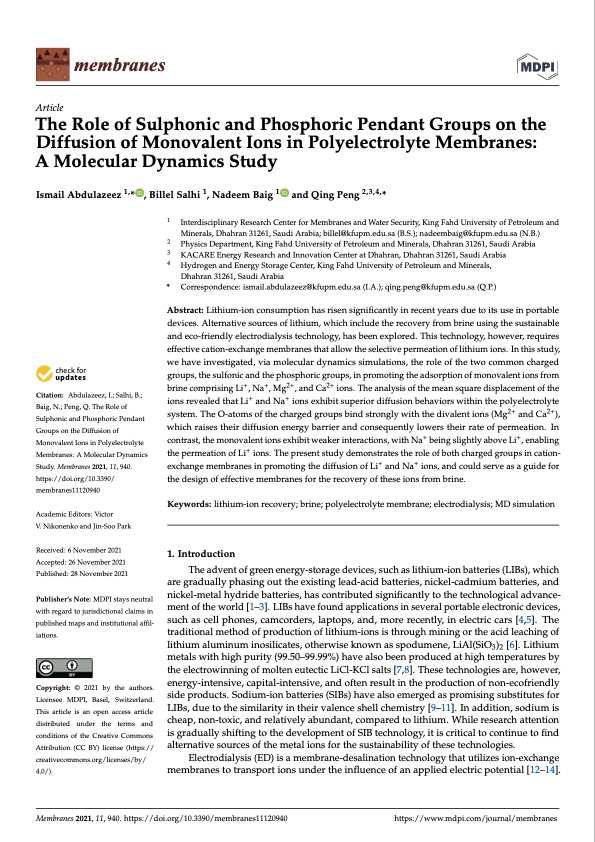
PDF Publication Title:
Text from PDF Page: 001
membranes Article The Role of Sulphonic and Phosphoric Pendant Groups on the Diffusion of Monovalent Ions in Polyelectrolyte Membranes: A Molecular Dynamics Study Ismail Abdulazeez 1,* , Billel Salhi 1, Nadeem Baig 1 and Qing Peng 2,3,4,* Citation: Abdulazeez,I.;Salhi,B.; Baig, N.; Peng, Q. The Role of Sulphonic and Phosphoric Pendant Groups on the Diffusion of Monovalent Ions in Polyelectrolyte Membranes: A Molecular Dynamics Study. Membranes 2021, 11, 940. https://doi.org/10.3390/ membranes11120940 Academic Editors: Victor V. Nikonenko and Jin-Soo Park Received: 6 November 2021 Accepted: 26 November 2021 Published: 28 November 2021 1 2 3 4 Dhahran 31261, Saudi Arabia * Correspondence: ismail.abdulazeez@kfupm.edu.sa (I.A.); qing.peng@kfupm.edu.sa (Q.P.) Abstract: Lithium-ion consumption has risen significantly in recent years due to its use in portable devices. Alternative sources of lithium, which include the recovery from brine using the sustainable and eco-friendly electrodialysis technology, has been explored. This technology, however, requires effective cation-exchange membranes that allow the selective permeation of lithium ions. In this study, we have investigated, via molecular dynamics simulations, the role of the two common charged groups, the sulfonic and the phosphoric groups, in promoting the adsorption of monovalent ions from brine comprising Li+, Na+, Mg2+, and Ca2+ ions. The analysis of the mean square displacement of the ions revealed that Li+ and Na+ ions exhibit superior diffusion behaviors within the polyelectrolyte system. The O-atoms of the charged groups bind strongly with the divalent ions (Mg2+ and Ca2+), which raises their diffusion energy barrier and consequently lowers their rate of permeation. In contrast, the monovalent ions exhibit weaker interactions, with Na+ being slightly above Li+, enabling the permeation of Li+ ions. The present study demonstrates the role of both charged groups in cation- exchange membranes in promoting the diffusion of Li+ and Na+ ions, and could serve as a guide for the design of effective membranes for the recovery of these ions from brine. Keywords: lithium-ion recovery; brine; polyelectrolyte membrane; electrodialysis; MD simulation 1. Introduction The advent of green energy-storage devices, such as lithium-ion batteries (LIBs), which are gradually phasing out the existing lead-acid batteries, nickel-cadmium batteries, and nickel-metal hydride batteries, has contributed significantly to the technological advance- ment of the world [1–3]. LIBs have found applications in several portable electronic devices, such as cell phones, camcorders, laptops, and, more recently, in electric cars [4,5]. The traditional method of production of lithium-ions is through mining or the acid leaching of lithium aluminum inosilicates, otherwise known as spodumene, LiAl(SiO3)2 [6]. Lithium metals with high purity (99.50–99.99%) have also been produced at high temperatures by the electrowinning of molten eutectic LiCl-KCl salts [7,8]. These technologies are, however, energy-intensive, capital-intensive, and often result in the production of non-ecofriendly side products. Sodium-ion batteries (SIBs) have also emerged as promising substitutes for LIBs, due to the similarity in their valence shell chemistry [9–11]. In addition, sodium is cheap, non-toxic, and relatively abundant, compared to lithium. While research attention is gradually shifting to the development of SIB technology, it is critical to continue to find alternative sources of the metal ions for the sustainability of these technologies. Electrodialysis (ED) is a membrane-desalination technology that utilizes ion-exchange membranes to transport ions under the influence of an applied electric potential [12–14]. Interdisciplinary Research Center for Membranes and Water Security, King Fahd University of Petroleum and Minerals, Dhahran 31261, Saudi Arabia; billel@kfupm.edu.sa (B.S.); nadeembaig@kfupm.edu.sa (N.B.) Physics Department, King Fahd University of Petroleum and Minerals, Dhahran 31261, Saudi Arabia KACARE Energy Research and Innovation Center at Dhahran, Dhahran 31261, Saudi Arabia Hydrogen and Energy Storage Center, King Fahd University of Petroleum and Minerals, Publisher’s Note: MDPI stays neutral with regard to jurisdictional claims in published maps and institutional affil- iations. Copyright: © 2021 by the authors. Licensee MDPI, Basel, Switzerland. This article is an open access article distributed under the terms and conditions of the Creative Commons Attribution (CC BY) license (https:// creativecommons.org/licenses/by/ 4.0/). Membranes 2021, 11, 940. https://doi.org/10.3390/membranes11120940 https://www.mdpi.com/journal/membranesPDF Image | Diffusion of Monovalent Ions in Polyelectrolyte

PDF Search Title:
Diffusion of Monovalent Ions in PolyelectrolyteOriginal File Name Searched:
membranes-11-00940-v2.pdfDIY PDF Search: Google It | Yahoo | Bing
Product and Development Focus for Infinity Turbine
ORC Waste Heat Turbine and ORC System Build Plans: All turbine plans are $10,000 each. This allows you to build a system and then consider licensing for production after you have completed and tested a unit.Redox Flow Battery Technology: With the advent of the new USA tax credits for producing and selling batteries ($35/kW) we are focussing on a simple flow battery using shipping containers as the modular electrolyte storage units with tax credits up to $140,000 per system. Our main focus is on the salt battery. This battery can be used for both thermal and electrical storage applications. We call it the Cogeneration Battery or Cogen Battery. One project is converting salt (brine) based water conditioners to simultaneously produce power. In addition, there are many opportunities to extract Lithium from brine (salt lakes, groundwater, and producer water).Salt water or brine are huge sources for lithium. Most of the worlds lithium is acquired from a brine source. It's even in seawater in a low concentration. Brine is also a byproduct of huge powerplants, which can now use that as an electrolyte and a huge flow battery (which allows storage at the source).We welcome any business and equipment inquiries, as well as licensing our turbines for manufacturing.| CONTACT TEL: 608-238-6001 Email: greg@infinityturbine.com | RSS | AMP |